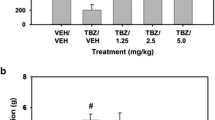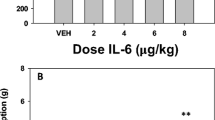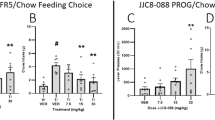Abstract
Rationale
Effort-related motivational symptoms, such as anergia, psychomotor retardation, and fatigue, are an important aspect of depression and other disorders. Motivational symptoms are resistant to some treatments, including serotonin transport (SERT) inhibitors.
Objectives
Tests of effort-based choice using operant behavior tasks (e.g., concurrent lever pressing/ chow feeding tasks) can be used as animal models of motivational symptoms. Tests of effort-related choice allow animals to choose between high-effort actions that lead to more highly valued rewards vs. low-effort alternatives that lead to less valued rewards (i.e., less preferred or lower magnitude). Rats treated with the vesicular monoamine transport inhibitor tetrabenazine, or the cytokine interleukin-1β (IL-1β), which are associated with depressive symptoms in humans, can alter effort-related choice, reducing selection of the high effort alternative (lever pressing) while increasing intake of freely available chow.
Methods
The present studies focused upon the ability of lisdexamfetamine (LDX) to increase exertion of effort in rats responding on effort-based choice tasks under several different conditions.
Results
LDX attenuated the shift from fixed ratio 5 lever pressing to chow intake induced by tetrabenazine and IL-1β. In contrast, the SERT inhibitor s-citalopram failed to reverse the effects of tetrabenazine. When given in combination with tetrabenazine+s-citalopram, LDX significantly increased lever pressing output compared to tetrabenaine+citalopram alone. LDX also increased work output in rats responding on a progressive ratio/chow feeding choice task.
Conclusions
LDX can increase work output in rats responding on effort-based choice tasks, which may have implications for understanding the neurochemistry of motivational symptoms in humans.





Similar content being viewed by others
References
Artaloytia JF, Arango C, Lahti A, Sanz J, Pascual A, Cubero P, Prieto D, Palomo T (2006) Negative signs and symptoms secondary to antipsychotics: a double-blind randomized trial of a single dose of placebo, haloperidol, and risperidone in healthy volunteers. Am J Psychiatry 163:488–493
Bardgett ME, Depenbrock M, Downs N, Points M, Green L (2009) Dopamine modulates effort-based decision making in rats. Behav Neurosci 123:242–251
Becker PM, Schwartz JR, Feldman NT, Hughes RJ (2004) Effect of modafinil on fatigue, mood, and health-related quality of life in patients with narcolepsy. Psychopharmacology (Berlin) 171:133–139
Beeler JA, Frazier CR, Zhuang X (2012) Putting desire on a budget: dopamine and energy expenditure, reconciling reward and resources. Front Integr Neurosci 6:49
Beeler JA, Faust RP, Turkson S, Ye H, Zhuang X (2015) Low dopamine D2 receptor increases vulnerability to obesity via reduced physical activity not increased appetitive motivation. Biol Psychiat. doi: 10.1016/j.biopsych.2015.07.009. [Epub ahead of print]
Cagniard B, Balsam PD, Brunner D, Zhuang X (2006) Mice with chronically elevated dopamine exhibit enhanced motivation, but not learning, for a food reward. Neuropsychopharmacology 31:1362–1370
Caligiuri MP, Gentili V, Eberson S, Kelsoe J, Rapaport M, Gillin JC (2003) A quantitative neuromotor predictor of antidepressant non-response in patients with major depression. J Affect Disord 77:135–141
Candy M, Jones L, Williams R, Tookman A, King M (2008) Psychostimulants for depression. Cochrane Database Syst Rev 2:CD006722
Chen JJ, Ondo WG, Dashtipour K, Swope DM (2012) Tetrabenazine for the treatment of hyperkinetic movement disorders: a review of the literature. Clin Ther 34:1487–1504
Chong TT, Bonnelle V, Manohar S, Veromann KR, Muhammed K, Tofaris GK, Hu M, Husain M (2015) Dopamine enhances willingness to exert effort for reward in Parkinson’s disease. Cortex 69:40–46
Cooper JA, Tucker VL, Papakostas GI (2014) Resolution of sleepiness and fatigue: a comparison of bupropion and selective serotonin reuptake inhibitors in subjects with major depressive disorder achieving remission at doses approved in the European Union. J Psychopharmacol 28:118–124
Cousins MS, Atherton A, Turner L, Salamone JD (1996) Nucleus accumbens dopamine depletions alter relative response allocation in a T-maze cost/benefit task. Behav Brain Res 74:189–197
Dantzer R (2009) Cytokine, sickness behavior, and depression. Immunol Allergy Clin North Am 29:247–264
Dantzer R, Meagher MW, Cleeland CS (2012) Translational approaches to treatment-induced symptoms in cancer patients. Nat Rev Clin Oncol 9:414–426
Demyttenaere K, De Fruyt J, Stahl SM (2005) The many faces of fatigue in major depressive disorder. J Neuropsychopharmacol 8:93–105
Devos D, Moreau C, Delval A, Dujardin K, Defebvre L, Bordet R (2013) Methylphenidate: a treatment for Parkinson’s disease? CNS Drugs 27:1–14
Fava M, Ball S, Nelson JC, Sparks J, Konechnik T, Classi P, Dube S, Thase ME (2014) Clinical relevance of fatigue as a residual symptom in major depressive disorder. Depress Anxiety 31(3):250–257
FDA News Release (2015) FDA expands uses of Vyvanse to treat binge-eating disorder. http://www.fda.gov/NewsEvents/Newsroom/PressAnnouncements/ucm432543.htm
Felger JC, Miller AH (2012) Cytokine effects on the basal ganglia and dopamine function: the subcortical source of inflammatory malaise. Front Neuroendocrinol 33(3):315–327
Felger JC, Lotrich FE (2013) Inflammatory cytokines in depression: neurobiological mechanisms and therapeutic implications. Neuroscience 246:199–229
Felger JC, Hernandez CR, Miller AH (2015) Levodopa reverses cytokine-induced reductions in striatal dopamine release. Int J Neuropsychopharmacol 18(4)
Floresco SB (2015) The nucleus accumbens: an interface between cognition, emotion, and action. Annu Rev Psychol 66:25–52
Floresco SB, Tse MT, Ghods-Sharifi S (2008) Dopaminergic and glutamatergic regulation of effort- and delay-based decision making. Neuropsychopharmacology 33:1966–1979
Frank S (2009) Tetrabenazine as anti-chorea therapy in Huntington disease: an open-label continuation study. Huntington Study Group/TETRA-HD Investigators. BMC Neurol 9:62
Frank S (2010) Tetrabenazine: the first approved drug for the treatment of chorea in US patients with Huntington disease. Neuropsychiatr Dis Treat 6:657–665
Friedman JH, Brown RG, Comella C, Garber CE, Krupp LB, Lou JS, Marsh L, Nail L, Shulman L, Taylor CB, Working Group on Fatigue in Parkinson’s Disease (2007) Fatigue in Parkinson’s disease: a review. Mov Disorder 22:297–308
Green TR (1997) Bupropion for SSRI-induced fatigue. J Clin Psychiatry 58:174
Guay DR (2010) Tetrabenazine, a monoamine-depleting drug used in the treatment of hyperkinetic movement disorders. Am J Geriatr Pharmacother 8:331–373
Hosking JG, Floresco SB, Winstanley CA (2015) Dopamine antagonism decreases willingness to expend physical, but not cognitive, effort: a comparison of two rodent cost/benefit decision-making tasks. Neuropsychopharmacology 40:1005–1015
Katz MM, Tekell JL, Bowden CL, Brannan S, Houston JP, Berman N, Frazer A (2004) Onset and early behavioral effects of pharmacologically different antidepressants and placebo in depression. Neuropsychopharmacology 29:566–579
Kegeles LD, Abi-Darghman A, Frankle WG, Gil R, Cooper TB, Slifstein M, Hwang DR, Huang Y, Haber SN, Laruelle M (2010) Increased synaptic dopamine function in associative regions of the striatum in schizophrenia. Arch Gen Psychiatry 67:231–239
Kerr CW, Drake J, Milch RA, Brazeau DA, Skretny JA, Crazeau GA, Donnelly JP (2012) Effects of methylphenidate on fatigue and depression: a randomized, double-blind, placebo-controlled trial. J Pain Symptom Manage 42:68–77
Keppel G (1991) Design and analysis: a researcher’s handbook, 3rd edn. Prentice-Hall, Englewood Cliffs, NJ
Lasser RA, Dirks B, Nasrallah H, Kirsch C, Gao J, Pucci ML, Knesevich MA, Lindsenmayer JP (2013) Adjunctive lisdexamfetamine dimesylate therapy in adult outpatients with predominant negative symptoms of schizophrenia: open-label and randomized-withdrawal phases. Neuropsychopharamcology 38:2140–2149
Mai B, Sommer S, Hauber W (2012) Motivational states influence effort-based decision making in rats: the role of dopamine in the nucleus accumbens. Cogn. Affect. Behav. Neurosci 12:74–84
Merali Z, Brennan K, Brau P, Anisman H (2003) Dissociating anorexia and anhedonia elicited by interleukin-1beta: anti-depressant and gender effects on responding for “free chow” and “earned” sucrose intake. Psychopharmacology (Berl) 165(4):413–418
Miller AH (2009) Mechanisms of cytokine-induced behavioral changes: psychoneuroimmunology at the translational interface. Brain Behav Immunity 23:149–158
Mott AM, Nunes EJ, Collins LE, Port RG, Sink KS, Hockemeyer J, Müller CE, Salamone JD (2009) The adenosine A2A antagonist MSX-3 reverses the effects of the dopamine antagonist haloperidol on effort-related decision making in a T-maze cost/benefit procedure. Psychopharmacology (Berl) 204:103–112
Najib J (2009) The efficacy and safety profile of lisdexamfetamine dimesylate, a prodrug of d-amphetamine, for the treatment of attention-deficit/hyperactivity disorder in children and adults. Clin Ther 31:142–176
Nunes EJ, Randall PA, Hart EE, Freeland C, Yohn SE, Baqi Y, Müller CE, López-Cruz L, Correa M, Salamone JD (2013a) Effort-related motivational effects of the VMAT-2 inhibitor tetrabenazine: implications for animal models of the motivational symptoms of depression. J Neurosci 33:19120–19130
Nunes EJ, Randall PA, Podurgiel S, Correa M, Salamone JD (2013b) Nucleus accumbens neurotransmission and effort-related choice behavior in food motivation: effects of drugs acting on dopamine, adenosine, and muscarinic acetylcholine receptors. Neurosci Biobehav Rev 37(9 Pt A):2015–2025
Nunes EJ, Randall PA, Estrada A, Epling B, Hart EE, Lee CA, Baqi Y, Müller CE, Correa M, Salamone JD (2014) Effort-related motivational effects of the pro-inflammatory cytokine interleukin 1-beta: studies with the concurrent fixed ratio 5/chow feeding choice task. Psychopharmacology (Berl) 231:727–773
Nutt D, Demyttenaere K, Janka Z, Aarre T, Bourin M, Canonico PL, Carrasco JL, Stahl S (2007) The other face of depression, reduced positive affect: the role of catecholamines in causation and cure. J Psychopharmacol 21:461–471
Padala PR, Padala KP, Monga V, Ramirez DA, Sullivan DH (2012) Reversal of SSRI associated apathy syndrome by discontinuation of therapy. Ann Pharmacother 46:e8
Pae CU, Lim HK, Han C, Patkar AA, Steffens DC, Masand PS, Lee C (2007) Fatigue as a core symptom in major depressive disorder: overview and the role of bupropion. Expert Rev Neurother 7:1251–1263
Papakostas GI, Nutt DJ, Hallet LA, Tucker VL, Krishen A, Fava M (2006) Resolution of sleepiness and fatigue in major depressive disorder: a comparison of bupropion and the selective serotonin reuptake inhibitors. Biol Psychiatry 15:1350–1355
Pardo M, Lopez-Cruz L, Valverde O, Ledent C, Baqi Y, Müller CE, Salamone JD, Correa M (2012) Adenosine A2A receptor antagonism and genetic deletion attenuate the effects of dopamine D2 antagonism on effort-based decision making in mice. Neuropharmacology 62:2068–2077
Pardo M, Lopez-Cruz L, Miguel NS, Salamone JD, Correa M (2015) Selection of sucrose concentration depends on the effort required to obtain it: studies using tetrabenazine, D1, D2, and D3 receptor antagonists. Psychopharmacology (Berl) 232:2377–2391
Randall PA, Lee CA, Nunes EJ, Yohn SE, Nowak V, Khan B, Shah P, Pandit S, Vemuri VK, Makriyannis A, Baqi Y, Müller CE, Correa M, Salamone JD (2014) The VMAT-2 inhibitor tetrabenazine affects effort-related decision making in a progressive ratio/chow feeding choice task: reversal with antidepressant drugs. PLoS One 9(6):e99320
Randall PA, Lee CA, Podurgiel SJ, Hart E, Yohn SE, Jones M, Rowland M, López-Cruz L, Correa M, Salamone JD (2015) Bupropion increases selection of high effort activity in rats tested on a progressive ratio/chow feeding choice procedure: implications for treatment of effort related motivational symptoms. Int J Neuropsychopharmacol 18(2):1–11. doi:10.1093/ijnp/pyu017
Randall PA, Pardo M, Nunes EJ, López Cruz L, Vemuri VK, Makriyannis A, Baqi Y, Müller CE, Correa M, Salamone JD (2012) Dopaminergic modulation of effort-related choice behavior as assessed by a progressive ratio chow task: pharmacological studies and role of individual differences. PLoS One 7(10):e47934
Ravindran AV, Kennedy SH, O'Donovan MC, Fallu A, Camacho F, Binder CE (2008) Osmotic-release oral system methylphenidate augmentation of antidepressant monotherapy in major depressive disorder: results of a double-blind, randomized, placebo-controlled trial. J Clin Psychiatry 69:87–94
Rizvi SJ, Geraci J, Ravindran A, Kennedy SH (2014) Predictors of response to adjunctive osmotic-release methylphenidate or placebo in patients with major depressive disorder: effects of apathy/anhedonia and fatigue. J Clin Psychopharmacol 34(6):755–759
Rosenberg PB, Lanctot KL, Drye LT, Herrmann N, Scherer RW, Bachmann DL, Mintzer JE, ADMET investigators (2013) Safety and efficacy of methylphenidate for apathy in Alzheimer’s disease: a randomized, placebo-controlled trial. J Clin Psychatry 74:810–816
Rothschild AJ, Raskin J, Wang CN, Marangell LB, Fava M (2014) The relationship between change in apathy and changes in cognition and functional outcomes in currently non-depressed SSRI-treated patients with major depressive disorder. Compr Psychiatry 55:1–10
Rowley HL, Kulkarni R, Gosden J, Brammer R, Hackett D, Heal DJ (2012) Lisdexamfetamine and immediate release d-amfetamine—differences in pharmacokinetic/pharmacodynamic relationships revealed by striatal microdialysis in freely-moving rats with simultaneous determination of plasma drug concentrations and locomotor activity. Neuropharmacology 63:1064–1074
Salamone JD, Correa M (2012) The mysterious motivational functions of mesolimbic dopamine. Neuron 76:470–485
Salamone JD, Steinpreis RE, McCullough LD, Smith P, Grebel D, Mahan K (1991) Haloperidol and nucleus accumbens dopamine depletion suppress lever pressing for food but increase free food consumption in a novel food choice procedure. Psychopharmacology (Berl) 104:515–521
Salamone JD, Cousins MS, Bucher S (1994) Anhedonia or anergia? Effects of haloperidol and nucleus accumbens dopamine depletion on instrumental response selection in a T-maze cost/benefit procedure. Behav Brain Res 65:221–229
Salamone JD, Arizzi MN, Sandoval MD, Cervone KM, Aberman JE (2002) Dopamine antagonists alter response allocation but do not suppress appetite for food in rats: contrast between the effects of SKF 83566, raclopride, and fenfluramine on a concurrent choice task. Psychopharmacology (Berl) 160:371–380
Salamone JD, Correa M, Mingote S, Weber SM (2003) Nucleus accumbens dopamine and the regulation of effort in food-seeking behavior: implications for studies of natural motivation, psychiatry, and drug abuse. J Pharmacol Exp Ther 305:1–8
Salamone JD, Correa M, Farrar A, Mingote SM (2007) Effort-related functions of nucleus accumbens dopamine and associated forebrain circuits. Psychopharmacology (Berl) 191:461–482
Salamone JD, Correa M, Nunes EJ, Randall PA, Pardo M (2012) The behavioral pharmacology of effort-related choice behavior: dopamine, adenosine and beyond. J Exp Anal Behav 97:125–146
Salamone JD, Koychev I, Correa M, McGuire P (2015) Neurobiological basis of motivational deficits in psychopathology. Eur Neuropsychopharmacol, 25(8):1225–1238
Sevy S, Rosenthal MH, Alvir J, Meyer S, Visweswaraish H, Gunduz-Bruce H, Schooler NR (2005) Double-blind, placebo-controlled study of modafinil for fatigue and cognition in schizophrenia patients treated with psychotropic medications. J Clin Psychiatry 66:839–843
Sommer S, Danysz W, Russ H, Valastro B, Flik G, Hauber W (2014) The dopamine reuptake inhibitor MRZ-9547 increases progressive ratio responding in rats. Int J Neuropsychopharmacol 17:2045–2056
Stahl SM (2002) The psychopharmacology of energy and fatigue. J Clin Psychiat 63(1):7–8
Stenman E, Lilja A (2013) Increased monoaminergic neurotransmission improves compliance with physical activity recommendations in depressed patients with fatigue. Med Hypotheses 80:47–49
Stotz G, Woggon B, Angst J (1999) Psychostimulants in the therapy of treatment-resistant depression. Review of the literature and findings from a retrospective study in 65 depressed patients. Dialogues Clin Neurosci 1(3):165–174
Tadano T, Nakagawasai O, Niijima F, Tan-No K, Kisara K (2000) The effects of traditional tonics on fatigue in mice differ from those of the antidepressant imipramine: a pharmacological and behavioral study. Am J Chin Med 28:97–104
Tanno T, Maguire DR, Henson C, France CP (2014) Effects of amphetamine and methylphenidate on delay discounting in rats: interactions with order of delay presentation. Psychopharmacology (Berl) 231:85–89
Treadway MT, Zald DH (2011) Reconsidering anhedonia in depression: lessons from translational neuroscience. Neurosci Biobehav Rev 35:537–555
Treadway MT, Bossaller NA, Shelton RC, Zald DH (2012) Effort-based decision making in major depressive disorder: a translational model of motivational anhedonia. J Abnorm Psychol 121(3):553–558
Wang JL, Oya S, Parhi AK, Lieberman BP, Ploessl K, Hou C, Kung HF (2010) In vivo studies of the SERT-selective [18F]FPBM and VMAT2-selective [18F]AV-133 radiotracers in a rat model of Parkinson’s disease. Nucl Med Biol 37:479–486
Wardle MC, Treadway MT, Mayo LM, Zald DH, de Wit H (2011) Amping up effort: effects of d-amphetamine on human effort-based decision-making. J Neurosci 31(46):16597–16602
Weisler R, Young J, Mattingly G, Gao J, Squires L, Adler L (2009) Long-term safety and effectiveness of lisdexamfetamine dimesylate in adults with attention-deficit/hyperactivity disorder. CNS Spectr 14:573–585
Yohn SE, Thompson C, Randall PA, Lee CA, Müller CE, Bagi Y, Correa M, Salamone JD (2015a) The VMAT-2 inhibitor tetrabenazine alters effort-related decision making as measured by the T-maze barrier choice task: reversal with the adenosine A2A antagonist MSX-3 and the catecholamine uptake blocker bupropion. Psychopharmacology (Berl) 232:1313–1323
Yohn SE, Santerre JL, Nunes EJ, Kozak R, Podurgiel SJ, Correa M, Salamone JD (2015b) The role of dopamine D1 receptor transmission in effort-related choice behavior: effects of D1 agonists. Pharmacol, Biochem Behav B135:217–226
Yohn SE, Collins SL, Contreras-Mora HM, Errante EL, Rowland MA, Correa M, Salamone JD (2015c). Not all antidepressants are created equal: differential effects of monoamine uptake inhibitors on effort-related choice behavior. Neuropychopharmacology. doi: 10.1038/npp.2015.188. [Epub ahead of print].
Young JL (2013) Use of lisdexamfetamine dimesylate in treatment of executive functioning deficits and chronic fatigue syndrome: a double blind, placebo controlled study. Psychiatry Res 207:127–133
Acknowledgments
We wish to thank Emily Errante for her assistance.
Author information
Authors and Affiliations
Corresponding author
Ethics declarations
Funding and disclosure
This research was supported by grants from NIH/NIMH, the University of Connecticut Research Foundation, and the Psychology Department Undergraduate Research Grant program. HC received an NSF Bridge to the Doctorate grant. JS has received grants from, and done consulting work for, Pfizer, Roche, Shire, and Prexa. PHH is an employee of Shire and holds stock and/or stock options in Shire. The authors have nothing to disclose in terms of competing interests.
Rights and permissions
About this article
Cite this article
Yohn, S.E., Lopez-Cruz, L., Hutson, P.H. et al. Effects of lisdexamfetamine and s-citalopram, alone and in combination, on effort-related choice behavior in the rat. Psychopharmacology 233, 949–960 (2016). https://doi.org/10.1007/s00213-015-4176-7
Received:
Accepted:
Published:
Issue Date:
DOI: https://doi.org/10.1007/s00213-015-4176-7




